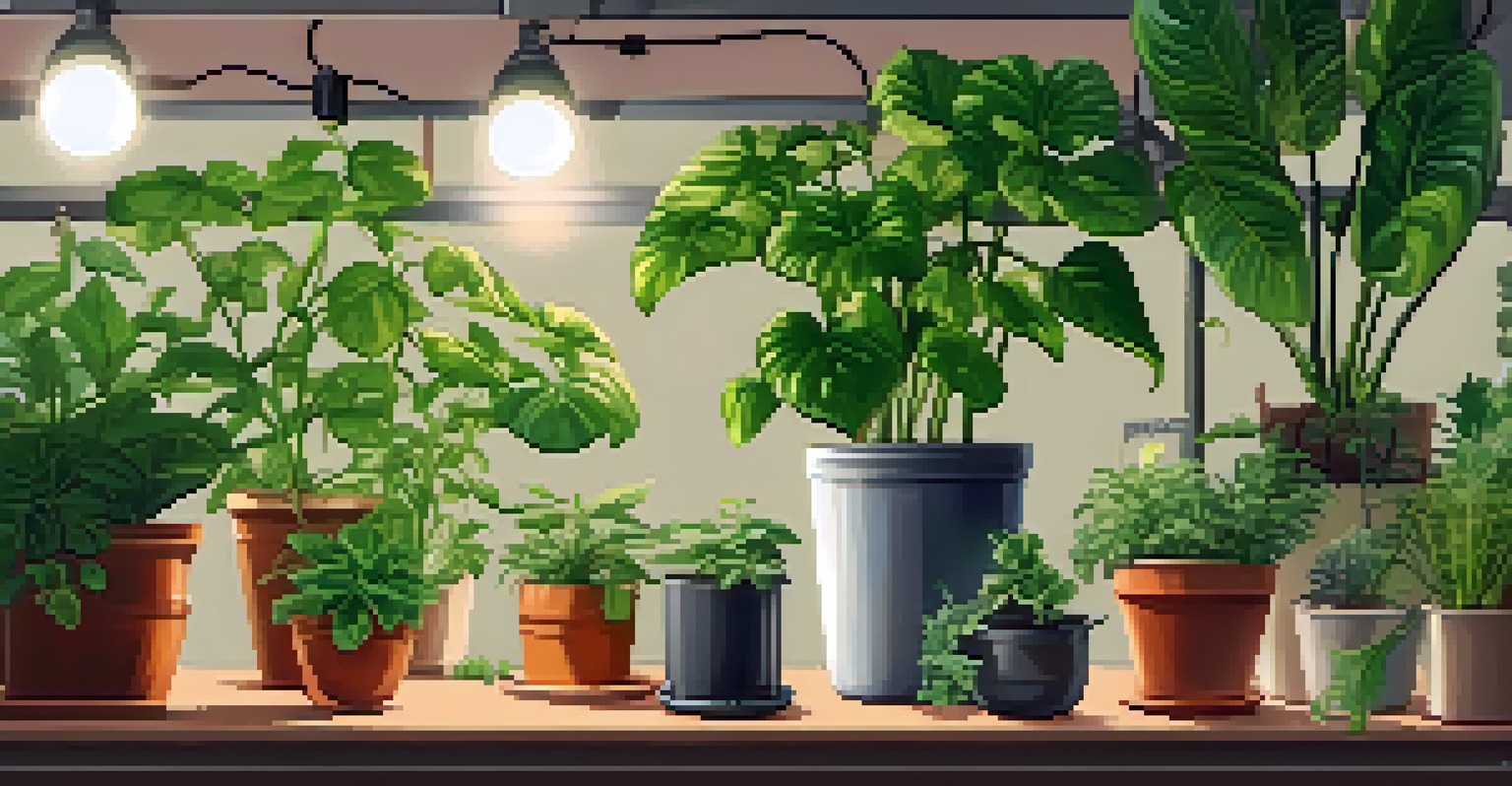How Light Influences Plant Growth and Behavior in Nature

The Role of Light in Photosynthesis
Light is the primary energy source for plants, driving the process of photosynthesis. During this process, plants convert light energy into chemical energy, which fuels their growth. The green pigment chlorophyll absorbs sunlight, primarily in the blue and red wavelengths, allowing plants to harness this energy effectively.
The clearest way into the Universe is through a forest wilderness.
Without sufficient light, plants struggle to produce the food they need to survive and thrive. This dependency on light means that plants have adapted to their specific environments, developing various strategies to maximize light absorption. For instance, plants in shaded areas may grow taller or develop larger leaves to capture more sunlight.
Understanding the role of light in photosynthesis helps us appreciate how crucial it is for healthy plant growth. It also highlights the delicate balance of ecosystems, where light availability influences not just individual plants, but entire communities of flora and fauna.
Phototropism: Plants Moving Towards Light
Have you ever noticed how houseplants seem to lean towards a window? This phenomenon is known as phototropism, where plants grow directionally in response to light. This behavior is driven by the plant hormone auxin, which redistributes itself in response to light, promoting faster growth on the side that is away from the light source.

Phototropism isn’t just a quirky trait; it's essential for survival. By growing towards light, plants maximize their photosynthetic potential, ensuring they receive the energy they need. This behavior is particularly evident in seedlings, which are often desperate to reach sunlight in their competition with other plants.
Light Drives Photosynthesis
Light is essential for plants as it powers photosynthesis, converting light energy into chemical energy for growth.
In nature, this means that plants can adapt to their environment, finding the best possible light conditions. Whether in dense forests or open fields, the ability to track and respond to light can be the difference between thriving and merely surviving.
Light Quality and Plant Growth
Not all light is created equal. The quality of light, which includes its color and intensity, plays a significant role in plant growth and behavior. Different wavelengths of light can have varying effects on plant processes, influencing everything from flowering to leaf growth.
Plants are the ultimate survivors, adapting to their environment in ways that are both remarkable and essential.
For example, blue light stimulates chlorophyll production and promotes vegetative growth, while red light is crucial for flowering and fruiting. This means that gardeners and farmers often manipulate light conditions—using grow lights or reflective materials—to optimize plant development.
In the wild, plants have evolved to thrive under the specific light conditions of their habitats. Coastal plants, for instance, may be adapted to the harsher, brighter sunlight, while those in shaded forest understories optimize for lower light levels, showcasing the intricate relationship between light quality and plant success.
The Impact of Day Length on Plant Behavior
Day length, or photoperiod, significantly influences plant behavior and growth cycles. Many plants are sensitive to the length of daylight, which tells them when to flower, set seeds, or enter dormancy. This sensitivity to day length is particularly evident in seasonal changes, where plants adapt their lifecycle to ensure survival.
For instance, long-day plants bloom when days are longer, usually in spring and summer, while short-day plants flower when days are shorter, typically in fall. This adaptation ensures that plants reproduce at the most favorable times, aligning their life cycles with seasonal weather patterns.
Plants Adapt to Light Conditions
Through mechanisms like phototropism, plants adjust their growth direction to maximize light absorption for survival.
As such, understanding photoperiodism helps us to predict plant behavior in different climates. Changes in climate can disrupt these natural cycles, affecting everything from agricultural yields to wildflower blooms, showcasing the intricate link between light and life.
Light Stress and Plant Resilience
While light is essential for plant growth, too much of it can lead to stress. Excessive light can cause photoinhibition, where the photosynthetic machinery is damaged, leading to reduced growth and vitality. Plants have developed various mechanisms to cope with this stress, including protective pigments and adjusting their leaf orientation.
For example, some plants can change the angle of their leaves to reduce light exposure during peak sunlight hours. Others may produce antioxidants to mitigate damage caused by excess light. These adaptations are crucial for survival, particularly in environments with fluctuating light conditions.
Understanding how plants respond to light stress not only highlights their resilience but also offers insights for agriculture. By studying these mechanisms, farmers can develop strategies to protect crops from light stress, ensuring healthier yields in the face of changing environmental conditions.
The Influence of Artificial Light on Plants
Artificial light has revolutionized our ability to grow plants indoors or in controlled environments. However, not all artificial lighting is equal, and its impact on plant growth can vary greatly depending on the type of light used. Grow lights, for instance, are designed to mimic natural sunlight and can be tailored to provide the optimal spectrum for plant growth.
Plants grown under artificial light must be monitored closely to mimic the natural light cycles they would experience outdoors. Factors such as light intensity, duration, and quality need to be managed to promote healthy growth. This is especially important in hydroponic or indoor farming systems, where growers rely entirely on artificial light.
Artificial Light's Impact on Growth
Artificial lighting can enhance plant growth, but its effectiveness depends on factors like light intensity and spectrum.
As we continue to explore new technologies in agriculture, understanding the effects of artificial light on plant behavior becomes increasingly important. This knowledge can help us create more efficient growing systems and enhance food production.
Conclusion: Light as a Key Environmental Factor
In conclusion, light is a vital environmental factor that influences plant growth and behavior in profound ways. From photosynthesis to flowering, plants have evolved intricate mechanisms to respond to their light environments. Understanding these processes not only deepens our appreciation for the natural world but also informs better practices in agriculture and horticulture.
As we face challenges such as climate change and habitat loss, recognizing the role of light in ecosystems becomes increasingly essential. By understanding how plants interact with light, we can work towards more sustainable practices that support both nature and food production.

Ultimately, light shapes life on Earth, guiding plants through their growth cycles and interactions within ecosystems. By continuing to study and respect these relationships, we can foster a healthier planet for generations to come.